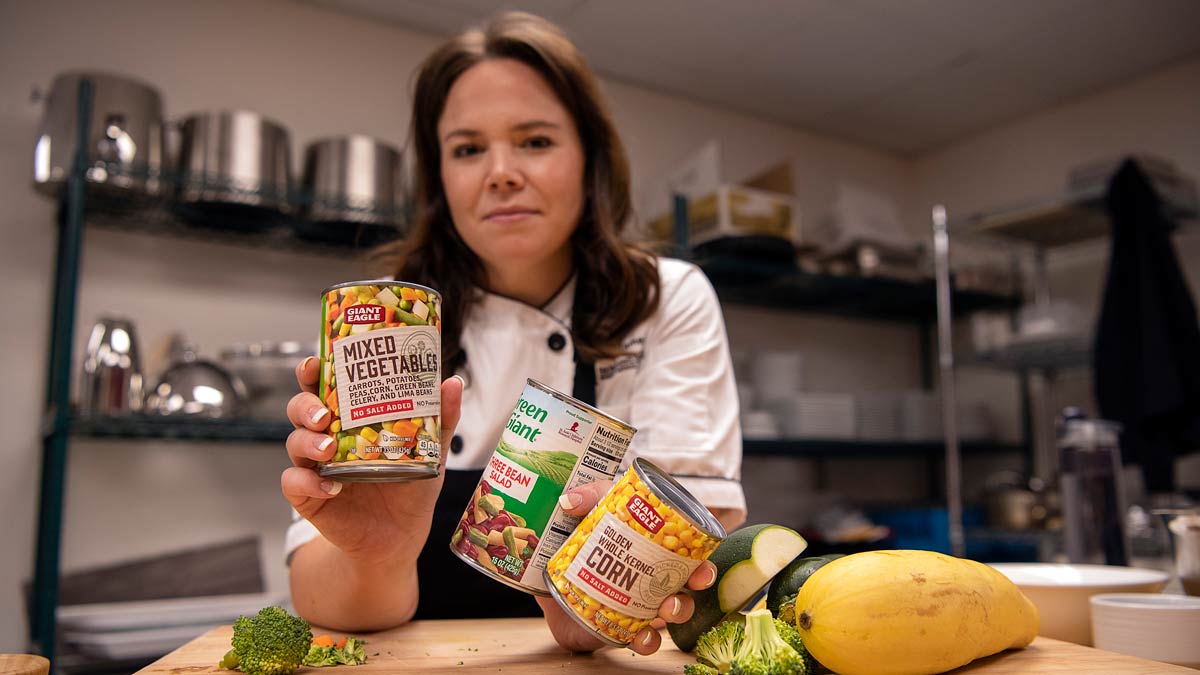How to eat healthy while cutting your grocery bill

With food costs rising at the grocery store during the COVID-19 pandemic, you may be scaling back your purchases or taking some unhealthy shortcuts to make ends meet.
But step away from the potato chips.
While we often hear that it’s more expensive to eat healthfully, that’s not necessarily true. There are many healthy foods that are cheaper than their less nutritious alternatives. A 2-pound bag of carrots, for example, costs about 5 cents per ounce and will probably last a lot longer than a bag of potato chips—a snack that will run you 16 cents an ounce.
Here, I’ll lay out some tips for selecting, preparing and cooking healthy foods on a budget. With a little bit of planning and smart shopping, you’ll see that you can cut your bill without sacrificing your health.
Ten tips for shopping healthy on a budget
- Choose store brands. Most of the time, they’ll be less expensive than name brands. To compare, check the unit price (or price per ounce) listed on the price tag. Not every store has this on the price tag, but most do—it’s usually in small print beside the total price.
- Shop sales. Find out what’s on sale before going to the store. Make a list and think about how you can use those ingredients to put together meals. Stock up on sale items you regularly use.
- Stick to your list. Make sure you’re not hungry when grocery shopping, as this can often lead to impulse buys. If you’ve had a balanced meal beforehand, you’ll be less tempted by foods that simply sound good in the moment (which can be anything and everything when we’re really hungry).
- Choose meals that can use the same ingredients. For example, if a recipe calls for 1 cup of chopped celery, plan to make another recipe later in the week that helps you use up the rest of the celery, or plan to use it with snacks such as hummus or peanut butter.
- Don’t buy pre-cut produce. Produce that’s already cut is not only more expensive but also has a shorter shelf life, meaning it’s more likely to go to waste. One exception: If you aren’t good at cutting fruits and veggies yourself and buying it this way means you’ll eat it, by all means go ahead and buy pre-cut.
- Buy bulk if possible. If your store has bulk bins, you can save money if you bring your own container and scoop out the amount you need.
- Order groceries online. This way you must search for each individual item on your list and can avoid impulse buys. Some stores charge a fee for this, but it’s often less than what you would’ve spent on impulse buys had you gone into the store.
- Reduce food waste. Take full advantage of your freezer. If you don’t end up using all your fresh produce, meats, dairy, cooked meals, bread or other food by the time it nears the end of its life—freeze it! Pretty much anything can be frozen. Use the FoodKeeper app or website to help maximize the freshness of your food.
- Use coupons. Most stores have digital coupons and will mail you coupons based on what you usually buy. Or clip coupons from newspapers or mailers, but keep in mind that these are usually for name brand items and may still be more expensive than buying store brand without coupons.
- Make more meatless meals. Proteins are often the most expensive part of the meal. Replacing meat with beans, tofu or another vegetarian protein source can lead to big savings over time. When you do choose to include meat in your meal, choose meats, fish and poultry based on what’s on sale. Try buying extra when your favorite protein is on sale and freeze for later use.
Affordable, healthy pantry staples to keep on hand
- Frozen vegetables (often 25 cents or less per serving for store brands)
- Frozen fruit (or buy fresh fruit when it’s on sale and freeze some for later use)
- Dried beans or low-sodium canned beans
- Tuna or salmon canned in water
- Brown rice
- Old-fashioned oats
- Whole wheat pasta
- Eggs
- Tofu (while it’s not everyone’s cup of tea, tofu is a great, inexpensive protein source that takes on the flavors of the foods you cook it with)
- Whole wheat flour
- Salsa
- Canned tomatoes
Twelve cheap and nutritious meal ideas to try
- Taco Night: beans, lettuce, salsa, cheese, whole wheat tortillas, lean (90% or higher) ground turkey or beef (buy on sale and freeze until needed)—or skip the meat to save even more money.
- Chicken or tofu stir-fry: Use whatever vegetables are on sale that week or whatever you already have on hand. Serve with rice. Make a sauce with low-sodium soy sauce, garlic powder, ground ginger and a little honey.
- Salsa chicken: Put chicken breasts in the crockpot with a jar of salsa. Cook on high for two to three hours. Serve in tacos, enchiladas or over rice and veggies.
- Enchiladas: Chop and sauté veggies, add a can of beans and a little bit of shredded cheese and roll into whole wheat tortillas. Place in a baking dish and cover with salsa or enchilada sauce. Bake at 350 degrees for 30 minutes.
- Pasta primavera: Sauté whatever vegetables you have on hand. Serve with whole wheat pasta. Add chicken or shrimp, if desired.
- Eggs are extremely versatile. They can be eaten with whole grain bread, avocado and some fruit for a balanced meal. Or make a frittata or veggie omelet or serve over a veggie hash of sautéed sweet potatoes, peppers and onions.
- Oatmeal can also be prepared and served many ways. Cook oats in the microwave or on the stove and mix in fruit, peanut butter, nuts, seeds or cinnamon. Try adding egg whites for extra protein (use pasteurized egg whites and stir frequently while cooking). Make oats savory by adding sautéed veggies and an egg on top. Try overnight oats or baked oatmeal for variety.
- Vegetarian chili: Sauté onion and peppers, then add beans, tomatoes and spices. Use lean ground turkey or beef, if desired.
- Tuna or salmon patties: Mix a can of tuna or salmon with an egg, some breadcrumbs and whatever add-ins you desire–fresh or dried herbs, cheeses, chopped spinach or other veggies. Serve with your vegetable of choice.
- Fried rice: Have leftover rice? Sauté some peppers, onion and a bag of frozen mixed veggies. Add the rice, soy sauce and scrambled egg.
- Curry: Sauté vegetables, then add one can of coconut milk, 1 tablespoon of curry paste, ½ tablespoon brown sugar, ½ tablespoon soy sauce and simmer. Serve over rice.
- Soups are a great way to use leftover proteins and grains. Make a veggie soup using low-sodium broth and frozen mixed vegetables. Add in leftover chicken, beef, beans or grains as desired.
Emilie Vandenberg is a registered dietitian at The Ohio State University Wexner Medical Center.




